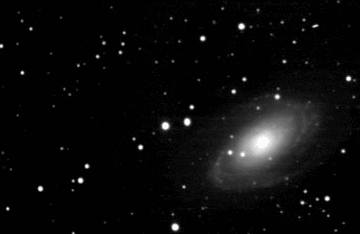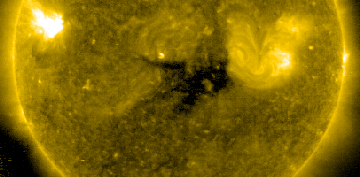 Did you miss last night's auroras? Next time get a wake-up call from Spaceweather PHONE.
Did you miss last night's auroras? Next time get a wake-up call from Spaceweather PHONE.
BIG AURORAS: NASA's Chandra X-ray Observatory has observed some spectacular Northern Lights on the planet Jupiter. The data may help researchers solve the mysteries of the biggest auroras in the solar system: full story.
ASTEROID FLYBY: Asteroid 2006 VV2 is about to fly past Earth. Tonight, March 30th, the 2 km-wide space rock will streak through the constellation Leo only 2 million miles away glowing like a 10th magnitude star. This makes it an easy target for backyard telescopes with CCD cameras.
On March 28th, Robert Long of Vado, New Mexico, caught the asteroid flying past spiral galaxy M81 in Ursa Major:

Click here for the full movie (1.6 MB)
"The movie consists of seventy-one 60-second exposures," says Long. "I used a 3-inch Orion ED80 refracting telescope and a SBIG ST8-XE CCD camera."
The Americas are favored for tonight's flyby, especially southern California where 2006 VV2 will glide right over the heads of observers at the moment of closest approach around 11 pm PDT. Astrophotographers, ready your cameras! [finder charts] [ephemeris]
Caveat impactor: There is no danger of a collision. At a distance of 2 million miles, the asteroid will be almost 9 times farther away than the Moon. The encounter is interesting because it affords astronomers an opportunity to study a large near-Earth asteroid at close range. Many professional observatories will be taking data, including NASA radars, which will ping 2006 VV2 to refine its orbit and learn more about its shape and composition. Stay tuned for updates.
more images: from Dobesberger Rudolf of Neuzeug, Austria; from Mike Broussard of Maurice, Louisiana.
CORONAL HOLE: Earth is staring down the barrel of a coronal hole on the sun. It's the dark patch in this March 30th ultraviolet image from SOHO:

Coronal holes are places in the sun's atmosphere where the sun's magnetic field opens up and allows solar wind to escape. A gust of wind from this particular hole will reach Earth on April 1st or 2nd, possibly sparking high-latitude geomagnetic storms. Sky watchers from Scandinavia to Alaska should be alert for auroras.
March 2007 Aurora Gallery
[aurora alerts] [night-sky cameras]

